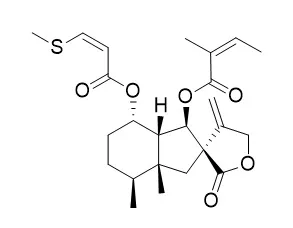| In vitro: |
| CNS Neurosci Ther. 2015 Dec;21(12):943-52. | | Bakkenolide-IIIa Protects Against Cerebral Damage Via Inhibiting NF-κB Activation.[Pubmed: 26511680 ] | This study was designed to examine the neuroprotective effects of Bakkenolide IIIa, a major novel compound extracted from the rhizome of P. trichinous.
METHODS AND RESULTS:
Transient focal cerebral damage model in rats and oxygen-glucose deprivation (OGD) in cultured hippocampal neurons were performed. The amount of apoptotic neurons was determined using TUNEL assay. The expressions of Bcl-2, Bax, Akt, ERK1/2, IKKβ, IκBα were measured using Western blot. The nuclear translocation and activation of NF-κB was measured using a fluorescence microscope and electrophoretic mobility shift assay (EMSA). Bakkenolide IIIa (4, 8, 16 mg/kg; i.g.) was administered immediately after reperfusion could reduce the brain infarct volume, and the neurological deficit, as well as a high dose of Bakkenolide IIIa, increases the 72 h survival rate in cerebrally damaged rats. In vitro data demonstrated that Bakkenolide IIIa could increase cell viability and decrease the amount of apoptotic cells in cultured primary hippocampal neurons exposed to OGD. Bakkenolide IIIa also dose-dependently increased the ratio of Bcl-2 to Bax. These results indicated that inhibition of apoptosis partly mediated the neuroprotection of Bakkenolide IIIa. Furthermore, Bakkenolide IIIa inhibited the phosphorylation of Akt, ERK1/2, IKKβ, IκBα, and p65 in cultured hippocampal neurons exposed to OGD. Bakkenolide IIIa not only inhibited the nuclear translocation of NF-κB in cultured neurons exposed to OGD, but also inhibited the activation of NF-κB in peri-infarct area in cerebrally damaged rats.
CONCLUSIONS:
Collectively, our findings indicated that Bakkenolide IIIa protects against cerebral damage by inhibiting AKT and ERK1/2 activation and inactivated NF-κB signaling. | | Planta Med. 2009 Feb;75(3):230-5. | | Bakkenolides from Petasites tricholobus and their neuroprotective effects related to antioxidant activities.[Pubmed: 19085813] | Four novel bakkenolides - bakkenolide Ia ( 1), bakkenolide IIa ( 2), Bakkenolide IIIa ( 3) and bakkenolide IVa ( 4) - were isolated from the extract of the rhizome of Petasites tricholobus.
METHODS AND RESULTS:
The structures were characterized by using NMR ( (1)H, (13)C, (1)H- (1)H COSY, HMQC, HMBC, and NOESY) and mass spectrometry. The neuroprotective activity of the compounds 1 - 4 was assayed with primary cultured neurons exposed to oxygen-glucose deprivation and oxidative insults. Antioxidant activity of the bakkenolides was evaluated by cell-free bioassays.
CONCLUSIONS:
The IN VITRO assay results showed that all these compounds exhibited significant neuroprotective and antioxidant activities. To our knowledge, this is the first report on the neuroprotective and antioxidant activities of bakkenolides. |
|






 Cell. 2018 Jan 11;172(1-2):249-261.e12. doi: 10.1016/j.cell.2017.12.019.IF=36.216(2019)
Cell. 2018 Jan 11;172(1-2):249-261.e12. doi: 10.1016/j.cell.2017.12.019.IF=36.216(2019) Cell Metab. 2020 Mar 3;31(3):534-548.e5. doi: 10.1016/j.cmet.2020.01.002.IF=22.415(2019)
Cell Metab. 2020 Mar 3;31(3):534-548.e5. doi: 10.1016/j.cmet.2020.01.002.IF=22.415(2019) Mol Cell. 2017 Nov 16;68(4):673-685.e6. doi: 10.1016/j.molcel.2017.10.022.IF=14.548(2019)
Mol Cell. 2017 Nov 16;68(4):673-685.e6. doi: 10.1016/j.molcel.2017.10.022.IF=14.548(2019)